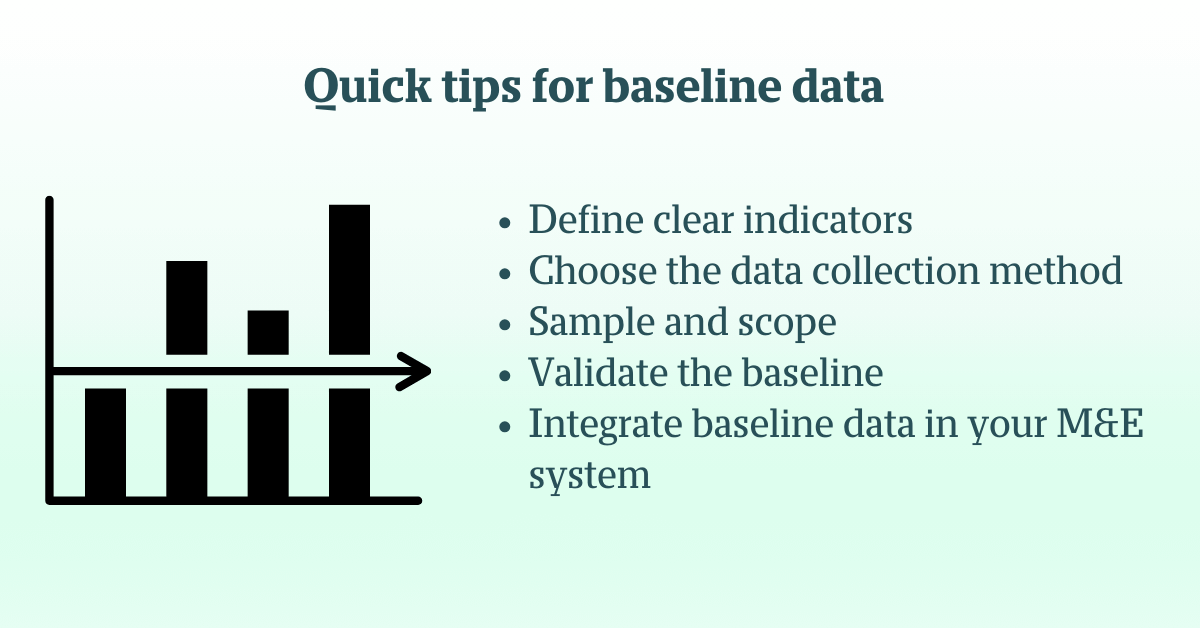The role of baseline data in indicator tracking and how to set it properly
Every nonprofit or NGO that wants to track progress and demonstrate results needs a baseline: a clear starting point. Without it, indicators lose much of their meaning, because you can’t know how far you’ve come if you don’t know where you started. This article explains what baselines are, why they matter in Monitoring and Evaluation, common challenges NGOs face in setting them, and practical steps for getting them right.

What is a baseline and why does it matter in indicator tracking?
A baseline is the initial measurement of an indicator before a project or program begins. It establishes the “zero point” against which all progress is measured.
They are necessary because they provide context for the indicators, as they reveal what the situation was before we started acting on it. They are useful for realistic target setting and act as good reference points that help us measure change over time.
For example, if a program aims to increase the percentage of girls completing secondary education, the baseline might be that currently 50% of girls in the target community graduate.
Common challenges with baseline data
The most commonly mentioned challenges with baseline data have to do with the lack of it, the cost or the complexity of attaining it.
In many settings, there is no pre-existing data and resource constraints might make it difficult for an organization to conduct a baseline survey which can be costly in terms of time and funds. In such cases, secondary government or partner data could help.
Then, timing and design can make it difficult for your organization to get baseline data. Sometimes projects need to start before a baseline is established. And baselines that require too many indicators may overwhelm staff or lead to inconsistent data. In this case, you should prioritize a small set of key indicators and try to build partnerships with local institutions to share data collection responsibilities.
Changing project scopes can also create challenges because if the objective of the programme or the project shifts and activities are re-designed or donors requirements change, then the original baseline may no longer be relevant to the expected outcomes. In such cases, you might need to adjust the baseline approach.
Tips for baseline data
- Define clear indicators: Follow the best practices for indicator definition. Watch our webinar for a deep dive in Indicators.
- Choose the data collection method: Balance accuracy with available resources when selecting between focus groups, surveys, government statistics, etc.
- Sample and scope: Decide whether you will measure the entire population targeted by your project or a representative sample. Watch our webinar for a deep dive in Sample sizes.
- Validate the baseline: Cross-check data findings with stakeholders, community members or secondary sources to ensure reliability.
- Integrate baseline data in your M&E system: Make use of the baseline data to support understanding of your project’s/programme’s progress.
Revisiting baselines for new project phases
For multi-year or multi-phase programs, it can make sense to revisit baselines when:
- A new project phase begins: Each phase may have distinct objectives and outcomes, making a fresh baseline more accurate for tracking that period.
- The target population changes: If a program expands to new districts or communities, the original baseline may not reflect the new context.
- Indicators are revised or added: When new indicators are introduced (for example, due to donor requests or evolving priorities), a new baseline ensures comparability over time.
- Significant external changes occur: Events like a pandemic, natural disaster, or major policy reform can drastically alter the starting point for communities, requiring a reset of baseline values.
Revisiting doesn’t always mean redoing an entire baseline survey, it could involve updating only the affected indicators, using a mix of fresh primary data and reliable secondary sources.
Did you know that ActivityInfo can support your indicator tracking activities and simplify the complete data lifecycle of your project or programme? If you wish to learn more about ActivityInfo and how it can support your organization’s indicator tracking you can always contact us.